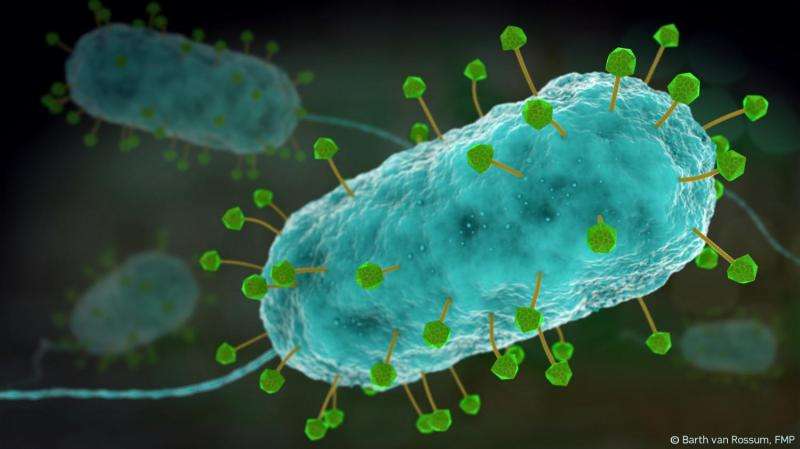Determining the 3-D structure of phages at atomic resolution

Phages have become a focus of research in the battle against antibiotic resistance. These bacteria-eating viruses have already proven effective in experiments against multidrug-resistant bacteria. However, the atomic structure of these small helpers is unknown. Researchers at the Leibniz-Forschungsinstitut für Molekulare Pharmakologie (FMP) in Berlin have now succeeded in developing a new method that makes it possible to determine the complex structure in detail, down to the atomic level. Their work is a further development in solid-state NMR and was published in the specialist journals Angewandte Chemie and Nature Protocols.
The WHO has long declared resistance to antibiotics a global health crisis and published a list of problematic germs, most recently in March, for which new antibiotics are urgently needed. But the search for new antibiotics has proven to be difficult: There has been no significant progress in development for over 40 years. This is why researchers are now more than ever looking for alternative treatments. Phages could constitute such an alternative. They are naturally occurring viruses that attack and consume certain bacteria, which is why they are also called "bacteriophages" (ancient Greek φαγεῖν phageín, "to devour"). Since there are special phages for every bacterium, it appears that they can be deployed more specifically than antibiotics, which always kill "good" bacteria as well. A lot of experiments with bacteriophages have already been carried out in Eastern Europe, and in the U.S. they have been genetically manipulated so they are able to cure infections of multiresistant germs in mice.
The atomic structure of the phages is not fully known to date. In the course of current therapy development, however, it would be tremendously useful to know how exactly they operate and what their 3-D structure looks like at atomic detail. "Phages are nanomachines that have been optimized by nature over millions of years. They consist of numerous components that are assembled into a complex architecture," explains Professor Dr. Adam Lange (FMP). Lange and his team have now succeeded in reaching a methodological milestone: The researchers have developed solid-state NMR (nuclear magnetic resonance spectroscopy) methods so that they can be used to determine the structure of phages down to the atomic level. Lange estimates that he will need about a year to resolve the complex structure of the phages. "By carrying out this fundamental research, we can make an important contribution to phage therapy."
The new method can be applied to other important systems as well. To provide access for laboratories around the world, in addition to the paper in Angewandte Chemie the researchers published a detailed protocol in Nature Protocols.
"Bacteriophages are becoming increasingly important as an alternative treatment approach due to the resistance of many pathogenic bacteria strains to antibiotics," Lange concludes. He is one of the leading minds in the field of making protein structures visible with NMR. "Therefore, we will now put our further development of the technology to use and investigate their complex structure as quickly as possible."
More information: Maximilian Zinke et al. Bacteriophage Tail Tube Assembly Studied by Proton-Detected 4D Solid-State NMR, Angewandte Chemie International Edition (2017). DOI: 10.1002/anie.201706060
Pascal Fricke et al. Backbone assignment of perdeuterated proteins by solid-state NMR using proton detection and ultrafast magic-angle spinning, Nature Protocols (2017). DOI: 10.1038/nprot.2016.190
Pascal Fricke et al. Backbone assignment of perdeuterated proteins by solid-state NMR using proton detection and ultrafast magic-angle spinning, Nature Protocols (2017). DOI: 10.1038/nprot.2016.190
Journal information: Nature Protocols , Angewandte Chemie , Angewandte Chemie International Edition
Provided by Forschungsverbund Berlin e.V. (FVB)




















